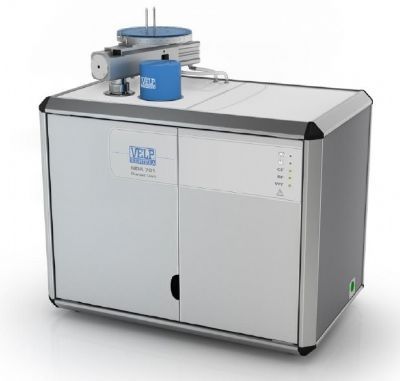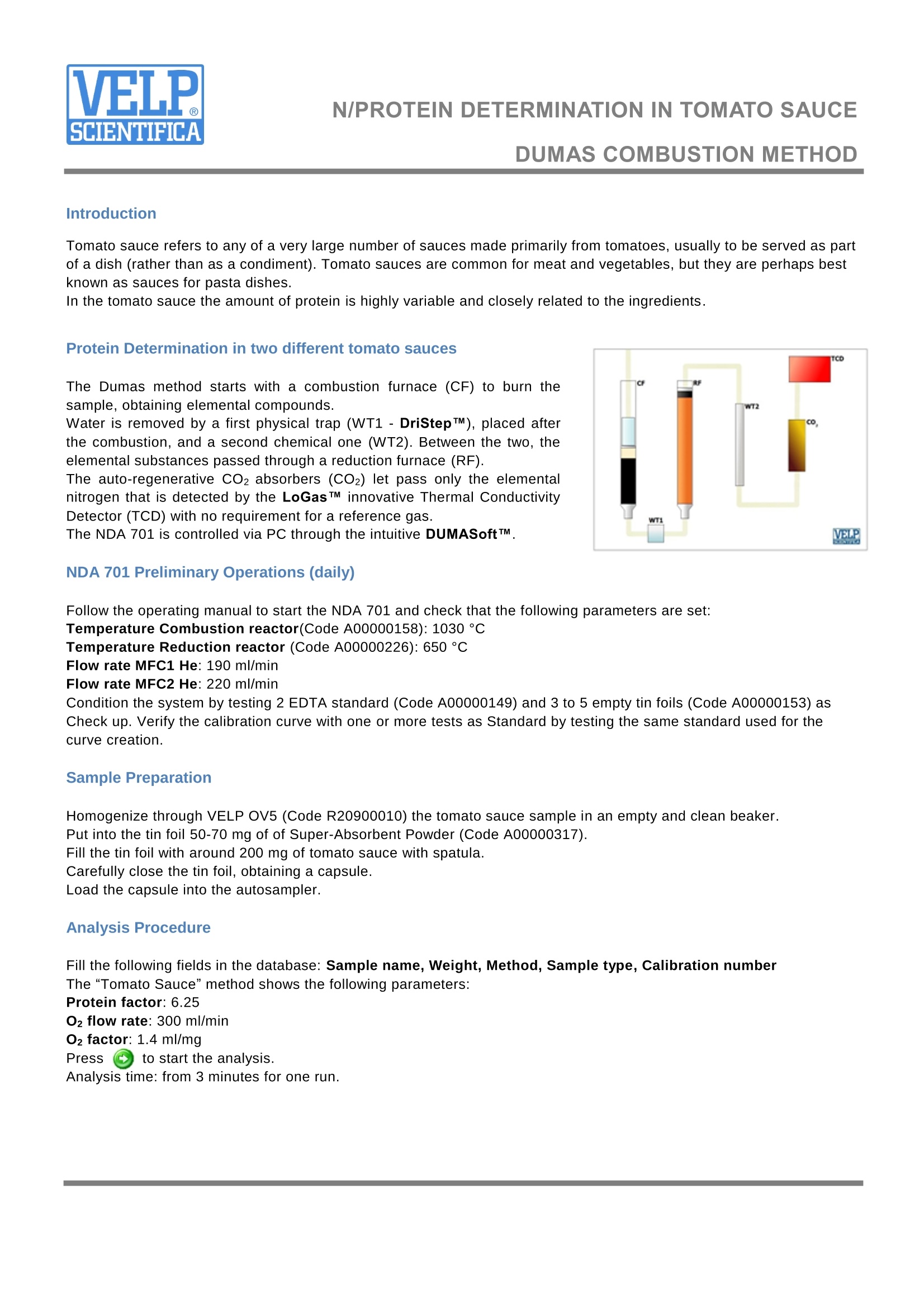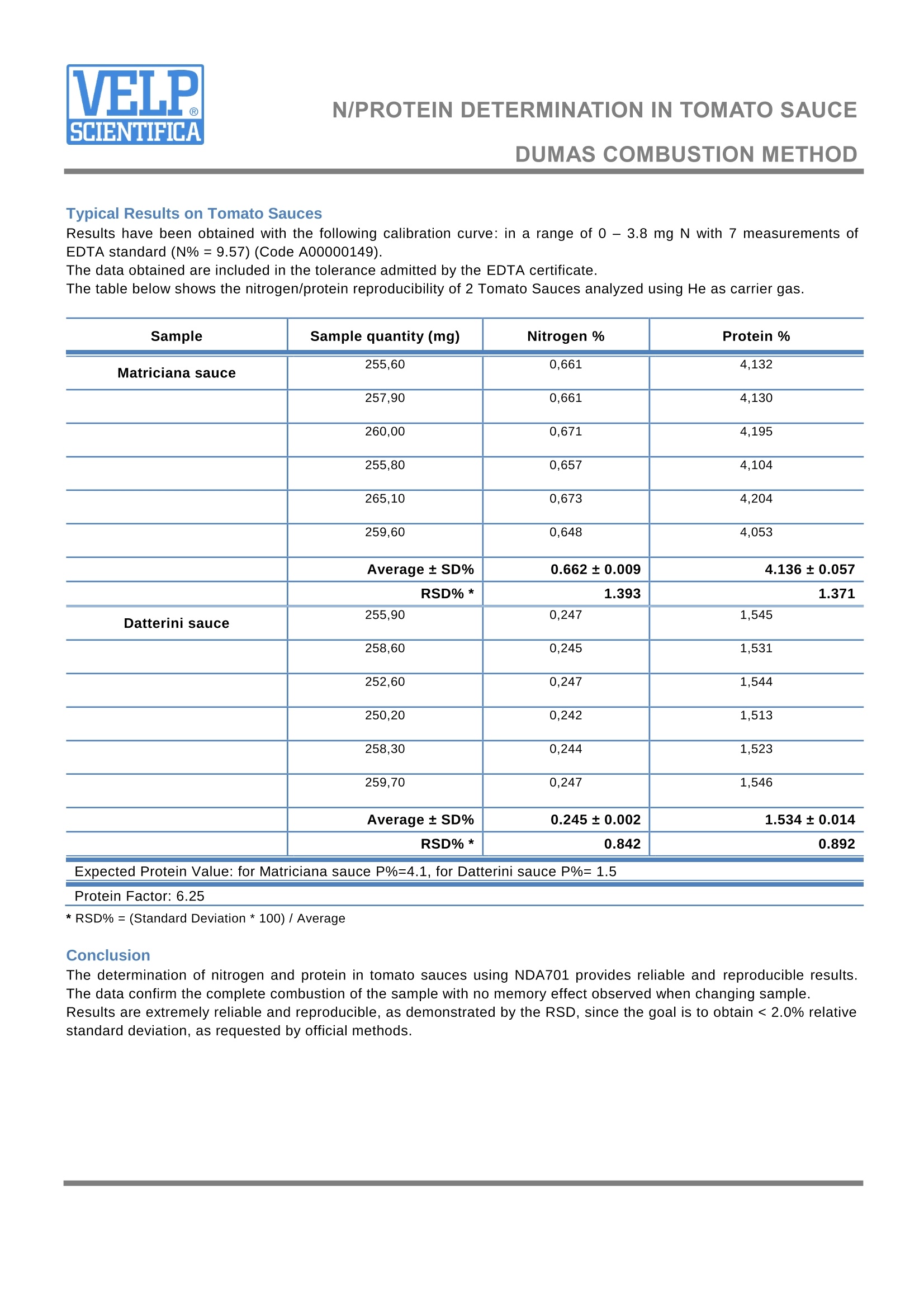
方案详情
文
用NDA701测定番茄酱中氮和蛋白质含量,结果可靠、重复性好。数据证实了样品完全燃烧,改变样品时没有观察到记忆效应。结果是非常可靠和可重复的,正如RSD所证明的,因为目标是获得相对标准偏差< 2.0%,按照方法的要求。
方案详情

APPLICATION NOTEF&F-D-005-2016/A3 N/PROTEIN DETERMINATION IN TOMATO SAUCEDUMAS COMBUSTION METHOD N/Protein Determination in TomatoSauce (Matriciana & Datterini) according to the Dumas combustion method Reference: Velp Internal Procedure Tested with VELP Scientifica NDA 701 Dumas Nitrogen Analyzer (Code F30800070) Introduction Tomato sauce refers to any of a very large number of sauces made primarily from tomatoes, usually to be served as partof a dish (rather than as a condiment). Tomato sauces are common for meat and vegetables, but they are perhaps bestknown as sauces for pasta dishes. In the tomato sauce the amount of protein is highly variable and closely related to the ingredients. Protein Determination in two different tomato sauces The Dumas method starts with a combustion furnace (CF) to burn thesample, obtaining elemental compounds. Water is removed by a first physical trap (WT1 -DriStepTM), placed afterthe combustion, and a second chemical one (WT2). Between the two, theelemental substances passed through a reduction furnace (RF). The auto-regenerative CO2absorbers (CO2) let pass only the elementalnitrogen that is detected by the LoGas TM innovative Thermal ConductivityDetector (TCD) with no requirement for a reference gas. The NDA 701 is controlled via PC through the intuitive DUMASoftTM. NDA 701 Preliminary Operations (daily) Follow the operating manual to start the NDA 701 and check that the following parameters are set: Temperature Combustion reactor(Code A00000158):1030°C Temperature Reduction reactor (Code A00000226):650°C Flow rate MFC1 He: 190 ml/min Flow rate MFC2 He: 220 ml/min Condition the system by testing 2 EDTA standard (CodeA00000149) and 3 to 5 empty tin foils (Code A00000153) asCheck up. Verify the calibration curve with one or more tests as Standard by testing the same standard used for thecurve creation. Sample Preparation Homogenize through VELP OV5 (Code R20900010) the tomato sauce sample in an empty and clean beaker. Put into the tin foil 50-70 mg of of Super-Absorbent Powder (Code A00000317). Fill the tin foil with around 200 mg of tomato sauce with spatula. Carefully close the tin foil, obtaining a capsule. Load the capsule into the autosampler. Analysis Procedure Fill the following fields in the database: Sample name, Weight, Method, Sample type, Calibration number The“Tomato Sauce" method shows the following parameters: Protein factor: 6.25 O2 flow rate: 300 ml/min O2 factor: 1.4 ml/mg Press to start the analysis. Analysis time: from 3 minutes for one run. Typical Results on Tomato Sauces Results have been obtained with the following calibration curve: in a range of 0 -3.8 mg N with 7 measurements ofEDTA standard (N%=9.57)(Code A00000149). The data obtained are included in the tolerance admitted by the EDTA certificate. The table below shows the nitrogen/protein reproducibility of 2 Tomato Sauces analyzed using He as carrier gas. Sample Sample quantity (mg) Nitrogen% Protein% Matriciana sauce 255,60 0,661 4,132 257,90 0,661 4,130 260,00 0,671 4,195 255,80 0,657 4,104 265,10 0,673 4,204 259,60 0,648 4,053 Average ± SD% 0.662±0.009 4.136±0.057 RSD%* 1.393 1.371 Datterini sauce 255,90 0,247 1,545 258,60 0,245 1,531 252,60 0,247 1,544 250,20 0,242 1,513 258,30 0,244 1,523 259,70 0,247 1,546 Average±SD% 0.245±0.002 1.534±0.014 RSD%* 0.842 0.892 Expected Protein Value: for Matriciana sauce P%=4.1, for Datterini sauce P%= 1.5 Protein Factor: 6.25 *RSD%=(Standard Deviation * 100) / Average Conclusion The determination of nitrogen and protein in tomato sauces using NDA701 provides reliable and reproducible results.The data confirm the complete combustion of the sample with no memory effect observed when changing sample.Results are extremely reliable and reproducible, as demonstrated by the RSD, since the goal is to obtain <2.0% relativestandard deviation, as requested by official methods. 番茄酱(Tomato sauce)指以番茄为主要原料做成的酱汁,通常作为菜肴的一部分(而不是佐料)使用。蕃茄酱通常用于肉类和蔬菜,但它们最广为人知的可能是意大利面食的酱汁。在番茄酱中,蛋白质的含量变化很大,而且与配料密切相关。检测设备:意大利VELP杜马斯定氮仪NDA 701参 照:Velp Internal Procedure检测结果:番茄酱的典型结果如下校准曲线所示:在0-3.8 mgN范围内,测量了7次EDTA标准(N% = 9.57)(代码A00000149)。获得的数据包含在EDTA证书认可的公差中。下表显示了以He为载体气体分析的2种番茄酱的氮/蛋白质重复性。结 论:用NDA701测定番茄酱中氮和蛋白质含量,结果可靠、重复性好。数据证实了样品完全燃烧,改变样品时没有观察到记忆效应。结果是非常可靠和可重复的,正如RSD所证明的,因为目标是获得相对标准偏差< 2.0%,按照方法的要求。
确定



还剩1页未读,是否继续阅读?
北京盈盛恒泰科技有限责任公司为您提供《番茄酱汁中N/蛋白质检测方案(定氮仪)》,该方案主要用于酱油中营养成分检测,参考标准--,《番茄酱汁中N/蛋白质检测方案(定氮仪)》用到的仪器有VELP-杜马斯定氮仪NDA701
相关方案
更多
该厂商其他方案
更多









